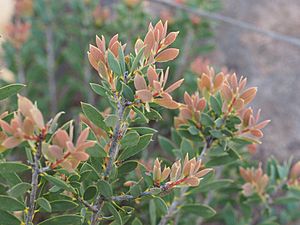Deane's paperbark facts for kids
Quick facts for kids Deane's paperbark |
|
|---|---|
 |
|
| Melaleuca deanei foliage | |
| Conservation status | |
| Scientific classification | |
| Genus: |
Melaleuca
|
| Species: |
deanei
|
Deane's paperbark, also known as Melaleuca deanei, is a special plant from the myrtle family. You can only find it in New South Wales, Australia. This plant is a type of shrub. It has cool, flaky bark, long oval leaves, and pretty white flowers that bloom in spring and summer. Sadly, there aren't many Deane's paperbark plants left. They live in only a few small areas, which means they are considered a vulnerable species.
Contents
What Does Deane's Paperbark Look Like?
Deane's paperbark is a shrub that can grow up to 3 m (10 ft) tall. It has grey, flaky bark that feels a bit like paper. When new parts of the plant grow, they are soft and white, like fur. As they get older, they become smooth.
Its leaves grow one after another along the stem. They are shaped like narrow ovals with a pointed tip. Each leaf is about 10 mm (0.4 in) to 31 mm (1 in) long and 3 mm (0.1 in) to 9 mm (0.4 in) wide. You can see many tiny oil glands on the leaves.
Flowers and Fruit
The flowers of Deane's paperbark are white. They grow in spikes at the ends of the branches. Even after the flowers bloom, the branches keep growing! Each flower spike can have anywhere from 3 to 25 individual flowers. The spikes can be up to 60 mm (2 in) long and 40 mm (2 in) across.
The petals are about 4 mm (0.2 in) to 6.5 mm (0.3 in) long and fall off as the flower opens. Inside each flower, there are many stamens (the parts that make pollen). They are grouped into five bundles.
Deane's paperbark usually flowers from July to November. After the flowers, the plant produces small, woody, barrel-shaped fruits called capsules. Each fruit is about 7 mm (0.3 in) to 9 mm (0.4 in) long and 7 mm (0.3 in) wide.
How Was It Named?
The plant Melaleuca deanei was officially described in 1886. This was done by a famous botanist named Ferdinand von Mueller. He found a sample of the plant that was collected by Henry Deane. Henry Deane was a railways engineer who also loved studying Australian plants. The plant was named deanei to honor him. He found the plant growing on sandy ground near the Lane Cove River.
Where Does It Live?
Deane's paperbark grows in only a few separate places in New South Wales. The two main areas are the Ku-ring-gai-Berowra district and the Holsworthy-Wedderburn district. You can also find smaller groups of these plants in places like Springwood, Wollemi, Yalwal, and near the Hawkesbury River.
These plants usually grow in woodlands on higher ground, especially where there is sandstone. Sometimes, they can also be found in heathland.
Why Is It Important?
It's tricky to count exactly how many individual Deane's paperbark plants there are. This is because they often grow new plants from their roots, creating "clones" of the original plant. It's rare to see new seedlings growing from seeds.
Experts believe there are between 1,000 and 3,000 plants in about 75 different locations. Scientists have studied how well this plant makes seeds compared to other common Melaleuca species. They found that Deane's paperbark produces fewer seeds. This is because it doesn't flower as much, not because of problems with pollination.
Protecting Deane's Paperbark
Deane's paperbark is listed as a threatened species by the New South Wales and Australian governments. This means it needs special protection. Even though some populations are in national parks, they still face dangers.
Threats to the Plant
- Habitat disturbance: Places where the plant grows can be damaged.
- Clearing: Land is sometimes cleared for building or other uses.
- Altered fire regimes: Changes in how often or how intensely bushfires happen can harm the plants.
- Trail maintenance: Work done on walking trails can disturb their habitat.
- Weed encroachment: Weeds can grow and take over the areas where Deane's paperbark lives.
How We Can Help
To protect Deane's paperbark, people are working to:
- Protect the sites from physical damage.
- Regularly check on the plants to see how they are doing.
- Remove weeds from known plant locations.
Gallery
-
M. deanei growing in Ku-ring-gai Chase National Park





